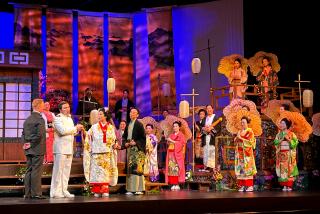THE PRICE OF A MASTERPIECE : Behind the Authenticity of ‘The Three-Cornered Hat’ Lies a Personal Tragedy
- Share via
Leonide Massine’s comic ballet “The Three-Cornered Hat,” which the Spanish Nacional Ballet will dance at the Performing Arts Center Oct. 6 through 11, embodies the soul of sunny Spain. But behind its authenticity lies a personal tragedy.
Massine first learned about the farruca and the other native dances in the work from a brilliant young Spaniard named Felix Fernandez Garcia, who earned his living as a printer but dazzled everyone who saw him as he improvised dances that expressed that mystical essence of Spanish dance-- duende , or soul.
Massine had met Garcia in his travels and introduced him to the legendary Serge Diaghilev, who quickly brought Garcia into his famous company, the Ballets Russes. Massine, Garcia, Diaghilev and the composer Manuel de Falla then went on a tour of the cities of Spain--Toledo, Seville, Cordova, Granada--stopping at museums, monasteries, cathedrals and, always, observing the local dancers with wonder.
All of it would go into the making of “The Three-Cornered Hat,” which premiered in London in 1919.
Falla, a shy man (Stravinsky described him as “modest and withdrawn as an oyster”), already had written incidental music for a one-act mimed farce by Gregorio Martinez Sierra entitled “El Corregidor y la Molinera,” based on Juan Ruiz Alarcon’s 19th-Century novel “El Sombrero de tres picos.” Drawn to the score, Diaghilev and Massine asked the composer if he would expand the work and re-score it for a larger orchestra. Falla agreed.
Garcia expected to be the star of the ballet. But it turned out that his greatest strength--his improvisatory genius--proved an insurmountable obstacle in a standard work. He simply could not dance to a set piece of music.
Attempts to teach him to dance even one solo, a Tarantella, made him increasingly distraught. Massine gave him a metronome to help him learn to dance in time. Garcia became obsessed with the instrument and carried it everywhere. But it didn’t help. Things got steadily and disturbingly worse.
After some aberrant behavior following a rehearsal, Garcia simply disappeared. Police found him “doing a demented dance on the altar steps of a South London church,” as Lydia Sokolova, one of Diaghilev’s famous ballerinas, wrote in her memoirs “Dancing for Diaghilev.”
Garcia was certified insane and was committed to an asylum in England, where he died.
“It must have been too much for him to see Leonide, who was not even a Spaniard, dancing what was to all intents and purposes his own farruca, “ Sokolova wrote. “Felix’s reason was the price fate demanded for the creation of a masterpiece.”
The plot of “The Three-Cornered Hat” concerns a miller and his wife, who catches the eye of the lecherous local governor or corregidor. The governor wears a three-cornered hat as a symbol of his class and position; hence the title of the ballet. The governor contrives to have the miller arrested so he can court the wife but she resists him and in the end, the miller and the villagers get their revenge.
The version to be seen in Costa Mesa is a reworking of the original by Ballet Nacional artistic director Jose Antonio. The sets and costumes follow Picasso’s original designs.
What: The Spanish National Ballet in Massine-Antonio’s “Three-Cornered Hat” and other repertory.
When: Tuesday, Oct. 6, through Saturday, Oct. 10, at 8 p.m.; Oct. 10 and 11 at 2 p.m.
Where: The Orange County Performing Arts Center, 600 Town Center Drive, Costa Mesa.
Whereabouts: One block east of the South Coast Plaza mall.
Wherewithal: $14 to $48.
Where to call: (714) 740-2000 (Ticketmaster).
More to Read
The biggest entertainment stories
Get our big stories about Hollywood, film, television, music, arts, culture and more right in your inbox as soon as they publish.
You may occasionally receive promotional content from the Los Angeles Times.










